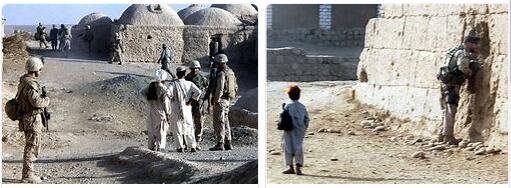Following the initial invasion of the country by US and British troops, a second operation was launched, now by the International Security Assistance Force (ISAF), which was established by the United Nations Security Council in late June. December 2001 to secure Kabul and the surrounding areas. The NATO assumed control of ISAF in 2003. Until the 23 of July of 2009, ISAF had around 64,500 soldiers from 42 countries, providing members of NATO core strength, although the greatest weight in terms of number of troops fell in the United States.
The initial attack removed the Taliban from power, but they have regained strength and positions since then. The war has been less successful than expected in its goal of restricting al Qaeda’s movement. Since 2006, stability in Afghanistan has been threatened by increased Taliban-led insurgent activity, high levels of illegal drug production, and a fragile government with little power outside Kabul.
Secret jails
At the beginning of 2002, the prisoners suspected of links with Al-Qaeda and the Taliban army who were captured in Afghanistan were imprisoned without any charge, in the X-Ray (X-Ray), Delta and Echo (Echo) camps, created to that end. Indeed, in the illegal base that the United States maintains in Cuban territory (Guantánamo).
In various countries around the world, the CIA and the Pentagon have maintained secret prisons in which Afghan and non-Afghan prisoners are held and tortured. Two of the most famous have been the one at Guantanamo Bay and the one at the US Bagram Air Base, north of Kabul.
Two after days of taking over as head of the White House, the 22 of January of 2009, Obama signed an executive order, the 13491, which ordered the closure of secret prisons ICFY also the infamous prison at Guantanamo base, whose 240 prisoners would be transferred to the United States or other countries within a year. For the most part, those promises of the Nobel Peace Prize have not been kept.
In Bagram Prison, where there are about 700 inmates, two teenagers, Issa Mohammed and Abdul Rashid, aged 17 and 16, respectively, were beaten and tortured, photographed naked and forced to view pornography, subjected to solitary confinement in cages of wire as if they were wild animals and preventing them from sleeping.
For several years, the Bagram prison could not be accessed by representatives of the International Red Cross, lawyers, or the press. The military authorities have always refused to name detainees, and did not allow photographs of the prison to be taken, not even from a distance.
Detainees in Afghanistan were taken to Bagram in 2002 and, as there were no facilities, they were placed in metal containers, and several died of suffocation. In 2005 it emerged that the prisoners Habibullah, an Afghan farmer, and Dilawar, a seller of spare parts for automotive equipment, were beaten, and chained to the ceiling. Later the case of the Pakistani neurosurgeon Aafin Siddique became known, who was also assassinated after five years in that prison.
Abu Ghraib (in Iraq), Bagram (in Afghanistan), and the illegal Guantanamo Naval Base (in Cuba), are the concentration camps of the greatest horror in the first decade of the 21st century.
Use of mercenaries
In violation of the International Convention against the recruitment, financing and training of mercenaries, approved by the UN in 1989, the United States reports the existence of around 30 transnational companies dedicated to providing “private security” services, through so-called “contractors”, who are nothing more than mercenaries.
These mercenaries have been participating in US raids against Al Qaeda “militants” in Iraq and Afghanistan. One of these Blackwater companies (now Xe Services), became famous in September 2007, due to the murder of 17 unarmed civilians in a busy square in the Iraqi capital. In all, there are 52 surveillance companies registered in Afghanistan, a country located in Asia according to BUSINESSCARRIERS, with an official number of 26,000 employees.
In October 2010, ” The New York Times ” reported that a private security service hired by the Department of Defense in the United States created an illicit spy ring in Afghanistan and Pakistan. The troop, made up of former soldiers and former CIA secret service workers, was spying on militia groups in those countries for more than a year and widely exceeded their powers, the newspaper said, referring to a secret report on the investigation that it was opened in the Pentagon. According to the brief, the Pentagon was the one who hired this group.
Present
More than 100,000 civilian deaths – which the Pentagon considers collateral damage – have resulted from 9 years of US occupation in Afghanistan. According to polls, 90 percent of Americans repudiate military actions in Afghanistan, where warlords and the Taliban control most of the Central Asian country.
In the years of US presence on Afghan soil, drug production and trafficking grew and even so Barack Obama – Nobel Peace Prize – intends to add 30,000 men to his troops there, while several members of NATO announce that they will withdraw. of the conflict.
In recent times the Wikileaks website has published thousands of documents showing the horrors that the war has brought to Afghanistan, including torture and massacres by the invaders against the Afghan people.
